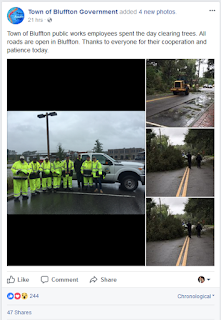By Tiger Wells, government affairs liaison
They say in life, change is the only constant. When it comes to the South Carolina Freedom of Information Act, the last few years have certainly proven that statement true.
There is a lot to review - whether observing the back and forth between the S.C. Supreme Court and General Assembly on issues related to meeting agendas, witnessing the fallout resulting from public bodies that have handled executive sessions improperly, or participating in the educational blitz that resulted from the legislature’s recent overhaul of FOIA related to fee schedules and such.
In 2014, the South Carolina Supreme Court ruled that agendas are not required for regularly scheduled local government meetings. That opinion, however was immediately undone by the S.C. General Assembly in 2015.
There is a lot to review - whether observing the back and forth between the S.C. Supreme Court and General Assembly on issues related to meeting agendas, witnessing the fallout resulting from public bodies that have handled executive sessions improperly, or participating in the educational blitz that resulted from the legislature’s recent overhaul of FOIA related to fee schedules and such.
In 2014, the South Carolina Supreme Court ruled that agendas are not required for regularly scheduled local government meetings. That opinion, however was immediately undone by the S.C. General Assembly in 2015.
In 2015, 2016 and 2017, South Carolina courts reprimanded local governing bodies for either entering executive session improperly by failing to announce the specific purpose for the executive session, or for improperly taking action after executive session without giving the public notice of such action. In those cases, municipalities and counties paid penalties ranging from just north of $13,000 to somewhere in the realm of $40,000. Costly lessons for sure.
Finally, in 2017, everyone following events at the State House witnessed the culmination of several years of work by legislators, the S.C. Press Association, the Municipal Association and various other stakeholder organizations and individuals with the passage of a significant FOIA overhaul in H.3352. This legislation introduced a number of changes regarding S.C. public bodies’ handling of public business.
Along with the changes made to FOIA, the legislation included expanded protections for personal information through changes to the Family Privacy Protection Act. The Municipal Association specifically addressed best practices for handling FOIA requests for information that could be used for commercial solicitation through educational conference calls and follow-up correspondence specifically addressing the issue of commercial solicitation.
From new fee schedule requirements to expanded protection against burdensome, vague, repetitive and otherwise improper FOIA requests, there was plenty in this legislation for advocates of efficient and effective government and transparency.
In response to these recent changes, the S.C. Press Association has updated its FOIA handbook.
It is said that sunlight is the best disinfectant. In the context of conducting the public’s business, this statement is widely accepted by government leaders as true. Perhaps more importantly, it has come to be expected and appreciated by the public itself.
The October meeting of the Municipal Finance Officers and Clerk Treasurers Association in Spartanburg will feature attorneys Lawrence Flynn and C.D. Rhodes presenting a timely guide through all of the FOIA flux mentioned above. Registration deadline is Friday, October 6.
It is said that sunlight is the best disinfectant. In the context of conducting the public’s business, this statement is widely accepted by government leaders as true. Perhaps more importantly, it has come to be expected and appreciated by the public itself.
The October meeting of the Municipal Finance Officers and Clerk Treasurers Association in Spartanburg will feature attorneys Lawrence Flynn and C.D. Rhodes presenting a timely guide through all of the FOIA flux mentioned above. Registration deadline is Friday, October 6.


